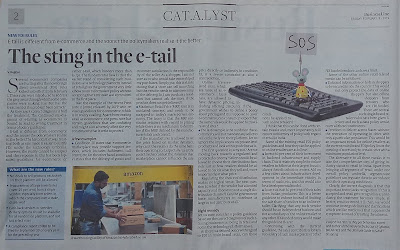March 2009, when I decided to start my blog “An Indian and A Retailer”, has definitely become a defining moment in my life journey. Ten years and 1,00,000 plus views later, the blog still continues to attract regular readers who often use its contents as a reference with regard to Indian Retail.
 The blog started off as a simple repository of my experiences and learning in the Indian Retail space. It went on to become the foundation stone of my journey as an author. This blog led to my first book “The INDIAN reTALEs”. That was followed by “Out Of Syllabus”, “BREAK FREE” and the latest one, “The Ultimate Guide to SMART SHOPPING”. This has been in addition to the various articles I have written for leading business publications.
The blog started off as a simple repository of my experiences and learning in the Indian Retail space. It went on to become the foundation stone of my journey as an author. This blog led to my first book “The INDIAN reTALEs”. That was followed by “Out Of Syllabus”, “BREAK FREE” and the latest one, “The Ultimate Guide to SMART SHOPPING”. This has been in addition to the various articles I have written for leading business publications.
All these must total up to approximately four lakh plus words over the years.
A BIG THANK YOU to all my readers who found my writing to be of interest and use. Many of them have given private feedback as also written public reviews.
Two anecdotes are worth sharing as part of this milestone.
The first is about the actual start of my journey in writing. In 2000 after I had returned from the UK after completing the Chevening Scholarship, Business Line invited me to write an article. This was to be about my stint at ASDA and was titled “Making an elephant dance”. The article detailed the interesting practices that were followed at ASDA to keep their large number of employees engaged and nimble footed to remain customer centric. The blog, in a manner of speaking continued from where this article had led me in the journey of being an author.
The second one is about the name for my blog. It was a challenge as I was conflicted by various ideas and options. The final decision was influenced by using the two identities that I am most proud of and has defined me as a person.
An Indian; growing up in the pre-liberalization period and witnessing the contribution that an individual can make as an ordinary citizen of India has always been motivating to me. Post liberalization, this has only been reinforced. In spite of several options to pursue a career abroad, the appeal of being an Indian contributing to the country’s growth in whatever small way possible has held greater appeal for me.
A Retailer; is how I think and operate. The experiences from this sector have defined my outlook and continue to do so. I am immensely grateful that God led me into this sector and am thankful to all my mentors who have taught me about the various facets about retail.
One of the topics I have written extensively about is that the retail sector in India should be granted industry status. This would not only spur this sector to faster and better growth but also contribute significantly to the Indian economy. My fond wish and hope as “An Indian and A Retailer”, is that this happens soon. I hope that the industry status is granted and a comprehensive policy for this sector, including both offline and online retailers gets rolled out at the earliest.
That would be fantastic and something to look forward to.






